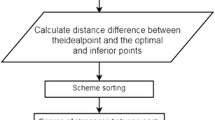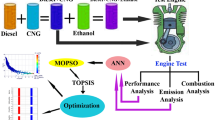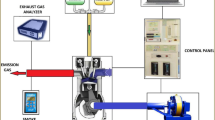Abstract
The present study highlights the inherent capabilities of ethanol-derris indica methyl ester (E-Dime) blends on performance and exhaust emission profiles of an existing compression ignition (CI) engine. Ethanol incorporation to Dime significantly reduces cumulated oxides of nitrogen and unburned hydrocarbon (NOHC) and particulate matter (PM) emissions of the CI engine along with improvement in brake thermal efficiency (Bth) and brake specific energy consumption. To this end, a multi-objective genetic algorithm (MOGA)-II is introduced to reveal Pareto solutions of the CI engine under the forthcoming Environmental Protection Agency Tier 4 exhaust emission mandates. Moreover, a multi-attribute decision-making-based technique for order preference by similarity to ideal solution (TOPSIS) is also introduced to pick out the optimal operating conditions of E-Dime blends. The MOGA-II-assisted TOPSIS-based trade-off investigation uncovers the optimal decision variables of 4.2 bar BMEP, 79.82% (by volume) biodiesel share and 20.18% (by volume) ethanol share with corresponding objective variables of 29.85% Bth, 0.645 g kW−1 h−1 NOHC, 0.523 g kW−1 h−1 carbon monoxide (CO) and 0.254 g kW−1 h−1 PM. The validation of the optimized results against the experimental one indicates a very lower deviation along with praiseworthy composite desirability of 0.972.















Similar content being viewed by others
Abbreviations
- BMEP:
-
Brake mean effective pressure
- BSEC:
-
Brake specific energy consumption
- CI:
-
Compression ignition
- CO:
-
Carbon monoxide
- DI:
-
Direct injection
- Dime:
-
Derris indica methyl ester
- DOE:
-
Design of experiments
- EPA:
-
Environmental Protection Agency
- IC:
-
Internal combustion
- MADM:
-
Multi-attribute decision making
- MOEA:
-
Multi-objective evolutionary algorithm
- MOGA:
-
Multi-objective genetic algorithm
- NOHC:
-
Cumulated oxide of nitrogen and unburned hydrocarbon
- PM:
-
Particulate matter
- POS:
-
Pareto optimal set or Pareto optimal solution
- SD:
-
Standard deviation
- TOPSIS:
-
Technique for order preference by similarity to ideal solution
- TSU:
-
Total sampling uncertainty
- UBHC:
-
Unburned hydrocarbon
- USP:
-
Unique selling point
- OFAT:
-
One-factor-at-a-time
- g kW− 1 h− 1 :
-
Gram per kilowatt-hour
- rpm:
-
Revolutions per minute
- s:
-
Second
- B th :
-
Brake thermal efficiency
- E-Dime:
-
Ethanol-Derris indica methyl ester
- E-Dime 1:
-
5% Ethanol + 95% Dime
- E-Dime 2:
-
10% Ethanol + 90% Dime
- E-Dime 3:
-
15% Ethanol + 85% Dime
- NOX :
-
Oxides of nitrogen
- E-Dime 4:
-
20% Ethanol + 80% Dime
- E-Dime 5:
-
25% Ethanol + 75% Dime
References
Bhowmik S, Panua R, Debroy D, Paul A. Artificial neural network prediction of diesel engine performance and emission fueled with diesel-kerosene-ethanol blends: a fuzzy based optimization. J Energy Res Technol. 2017;139(4):042201–10.
Paul A, Bhowmik S, Panua R, Debroy D. Artificial neural network based prediction of performances-exhaust emissions of diesohol piloted dual fuel diesel engine under varying compressed natural gas flowrates. J Energy Res Technol. 2018;140(11):112201–9.
Bhowmik S, Panua R, Kumar Ghosh S, Debroy D, Paul A. A comparative study of artificial intelligence based models to predict performance and emission characteristics of a single cylinder diesel engine fueled with diesosenol. J Thermal Sci Eng Appl. 2018;10(4):041004–11.
Bhowmik S, Panua R, Ghosh SK, Paul A, Debroy D. Prediction of performance and exhaust emissions of diesel engine fuelled with adulterated diesel: an artificial neural network assisted fuzzy-based topology optimization. Energy Environ. 2018;29(8):1413–37.
Bhowmik S, Paul A, Panua RS, Ghosh SK, Debroy D. Artificial intelligence based gene expression programming (GEP) model prediction of diesel engine performances and exhaust emissions under Diesosenol fuel strategies. Fuel. 2019;235:317–25.
Sureshkumar K, Velraj R, Ganesan R. Performance and exhaust emission characteristics of a CI engine fueled with Pongamia pinnata methyl ester (PPME) and its blends with diesel. Renew Energy. 2008;33(10):2294–302.
Paul A, Panua RS, Debroy D, Bose PK. Effect of compressed natural gas dual fuel operation with diesel and Pongamia pinnata methyl ester (PPME) as pilot fuels on performance and emission characteristics of a CI (compression ignition) engine. Energy. 2014;68:495–509.
Aydin H, İlkılıç C. Effect of ethanol blending with biodiesel on engine performance and exhaust emissions in a CI engine. Appl Therm Eng. 2010;30(10):1199–204.
Banapurmath NR, Tewari PG. Performance, combustion, and emissions characteristics of a single-cylinder compression ignition engine operated on ethanol-biodiesel blended fuels. Proc Inst Mech Eng Part A J Power Energy. 2010;224(4):533–43.
Mistri GK, Aggarwal SK, Longman D, Agarwal AK. Performance and emission investigations of Jatropha and Karanja biodiesels in a single-cylinder compression-ignition engine using endoscopic imaging. ASME J Energy Resour Technol. 2015;138(1):011202–13.
Sivaramakrishnan K. Investigation on performance and emission characteristics of a variable compression multi fuel engine fuelled with Karanja biodiesel–diesel blend. Egypt J Pet. 2018;27(2):177–86.
Chauhan BS, Kumar N, Cho HM, Lim HC. A study on the performance and emission of a diesel engine fueled with Karanja biodiesel and its blends. Energy. 2013;56:1–7.
Altaie MAH, Janius RB, Rashid U, Taufiq-Yap YH, Yunus R, Zakaria R, Adam NM. Performance and exhaust emission characteristics of direct-injection diesel engine fueled with enriched biodiesel. Energy Convers Manag. 2015;106:365–72.
Altin R, Selim C, Yücesu HS. The potential of using vegetable oil as fuel for diesel engines. Energy Convers Manag. 2001;42:529–38.
Subbaiah GV, Gopal KR. An experimental investigation on the performance and emission characteristics of a diesel engine fuelled with rice bran biodiesel and ethanol blends. Int J Green Energy. 2011;8(2):197–208.
Bhale PV, Deshpande NV, Thombre SB. Improving the low temperature properties of biodiesel fuel. Renew Energy. 2009;34:794–800.
Paul A, Panua RS, Debroy D, Bose PK. Effect of diesel–Ethanol–PPME (Pongamia pinata methyl ester) blends as pilot fuel on CNG dual-fuel operation of a CI engine: a performance-emission trade-off study. Energy Fuels. 2015;29:2394–407.
Paul A, Panua RS, Debroy D, Bose PK. A performance emission trade off study of a CI engine fueled by compressed natural gas (CNG)/diesel–ethanol-PPME blend combination. Environ Prog Sustain Energy. 2016;35(2):517–30.
Paul A, Panua RS, Debroy D. An experimental study of combustion, performance, exergy and emission characteristics of a CI engine fueled by diesel-ethanol-biodiesel blends. Energy. 2017;141:839–52.
Paul A, Panua RS, Bose PK, Banerjee R. An experimental study of performance and emission parameters of a compression ignition engine fueled by different blends of Diesel-Ethanol-biodiesel. In: 2013 International conference on energy efficient technologies for sustainability; 2013. https://doi.org/10.1109/ICEETS.2013.6533485.
Paul A, Bose PK, Panua RS, Debroy D. Study of performance and emission characteristics of a single cylinder CI engine using diethyl ether and ethanol blends. J Energy Inst. 2015;88:1–10.
Paul A, Panua RS, Debroy D, Bose PK. Effect of diethyl ether and ethanol on performance, combustion, and emission of single-cylinder compression ignition engine. Int J Ambient Energy. 2014;38(1):2–13.
Datta A, Mandal BK. Engine performance, combustion and emission characteristics of a compression ignition engine operating on different biodiesel-alcohol blends. Energy. 2017;125:470–83.
Lu X, Ma J, Ji L, Huang Z. Simultaneous reduction of NOx emission and smoke opacity of biodiesel-fueled engines by port injection of ethanol. Fuel. 2008;87(7):1289–96.
Paul A, Panua RS, Debroy D, Bose PK. An experimental study of the performance, combustion and emission characteristics of a CI engine under dual fuel mode using CNG and oxygenated pilot fuel blends. Energy. 2015;86:560–73.
Zhu L, Cheung CS, Zhang WG, Huang Z. Combustion, performance and emission characteristics of a DI diesel engine fueled with ethanol–biodiesel blends. Fuel. 2011;90:1743–50.
Hansen AC, Lyne PWL. Ethanol-diesel blends a step towards a bio-based fuel for diesel engines. ASAE Paper. 2001;10(13031/2013):3586.
Navid A, Khalilarya S, Taghavifar H. Comparing multi-objective non-evolutionary NLPQL and evolutionary genetic algorithm optimization of a DI diesel engine: DoE estimation and creating surrogate model. Energy Convers Manag. 2016;126:385–99.
Hu N, Zhou P, Yang J. Comparison and combination of NLPQL and MOGA algorithms for a marine medium-speed diesel engine optimization. Energy Convers Manag. 2017;133:138–52.
Kim HJ, Park SH. Optimization study on exhaust emissions and fuel consumption in a dimethyl ether (DME) fueled diesel engine. Fuel. 2016;182:541–9.
Sarafraz MM, Christo FC. Thermodynamic assessment and techno-economic analysis of a liquid indium-based chemical looping system for biomass gasification. Energy Convers Manag. 2020. https://doi.org/10.1016/j.enconman.2020.113428.
Sarafraz MM, Tran NN, Pourali N, Rebrov EV, Hessel V. Thermodynamic potential of a novel plasma-assisted sustainable process for co-production of ammonia and hydrogen with liquid metals. Energy Convers Manag. 2020. https://doi.org/10.1016/j.enconman.2020.112709.
Sarafraz MM, Tlili I, Tian Z, Bakouri M, Safaei MR. Smart optimization of a thermosyphon heat pipe for an evacuated tube solar collector using response surface methodology (RSM). Phys A. 2019. https://doi.org/10.1016/j.physa.2019.122146.
Sarafraz MM, Safaei MR, Goodarzi M, Arjomandi M. Experimental investigation and performance optimisation of a catalytic reforming micro-reactor using response surface methodology. Energy Convers Manag. 2019. https://doi.org/10.1016/j.enconman.2019.111983.
Sarafraz MM, Jafarian M, Arjomandi M, Nathan GJ. The relative performance of alternative oxygen carriers for liquid chemical looping combustion and gasification. Int J Hydrog Energy. 2017;42(26):16396–407.
Sarafraz MM, Safaei MR, Goodarzi M, Arjomandi M. Reforming of methanol with steam in a micro-reactor with Cu–SiO2 porous catalyst. Int J Hydrog Energy. 2019;44(36):19628–39.
Manne JR. Multiobjective optimization in water and environmental systems management-MODE approach. In: Pijush S, editor. Handbook of research on advanced computational techniques for simulation-based engineering. London: IGI Global; 2015. p. 120–36.
Jeffers JNR. Design of experiments. NERC Open Research Archive; 1978.
Anderson MJ, Whitcomb PJ. Design of experiments. Kirk-Othmer Encycl Chem Technol; 2000.
Beyer HG. The theory of evolutionary strategies. Natural computing series. Berlin: Springer; 2001.
Smolinski TG. Multi-objective evolutionary algorithms. In: Jaeger D, Jung R, editors. Encyclopedia of computational neuroscience. Berlin: Springer; 2014. p. 1–4.
Poloni C, Pediroda V. GA coupled with computationally expensive simulations: tools to improve efficiency. In: Quagliarella D, Periaux J, Poloni C, Winter G, editors. Genetic algorithms and evolution strategies in engineering and computer science. New York: Wiley; 1997. p. 267–88.
Poles S, Geremia P, Campos F, Weston S, Islam M. MOGA-II for an automotive cooling duct optimization on distributed resources. In: Obayashi S, Deb K, Poloni C, Hiroyasu T, Murata T, editors. Evolutionary multi-criterion optimization. Lecture notes in computer science. Berlin: Springer; 2007. p. 633–44.
Hwang CL, Yoon K. Multiple attribute decision making: methods and applications a state-of-the-art survey. Berlin: Springer; 1981.
Assari A, Mahesh T, Assari E. Role of public participation in sustainability of historical city: usage of TOPSIS method. Indian J Sci Technol. 2012. https://doi.org/10.17485/ijst/2012/v5i3.2.
Serafim O, Gwo-Hshiung T. Compromise solution by MCDM methods: a comparative analysis of VIKOR and TOPSIS. Eur J Oper Res. 2004;156(2):445–55.
Bhowmik S, Paul A, Panua RS, Ghosh SK, Debroy D. Performance-exhaust emission prediction of diesosenol fueled diesel engine: an ANN coupled MORSM based optimization. Energy. 2018;153:212–22.
Author information
Authors and Affiliations
Corresponding author
Additional information
Publisher's Note
Springer Nature remains neutral with regard to jurisdictional claims in published maps and institutional affiliations.
Rights and permissions
About this article
Cite this article
Debroy, D., Bhowmik, S., Panua, R. et al. Performance–exhaust emission optimization of compression ignition engine under E-Dime strategies. J Therm Anal Calorim 147, 3787–3801 (2022). https://doi.org/10.1007/s10973-021-10742-1
Received:
Accepted:
Published:
Issue Date:
DOI: https://doi.org/10.1007/s10973-021-10742-1




